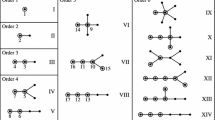Abstract
General linear methods are multistage multivalue methods. This large family of numerical methods for ordinary differential equations, includes Runge–Kutta and linear multistep methods as special cases. G-symplectic general linear methods are multivalue methods which preserve a generalization of quadratic invariants. If Q is an invariant quadratic form then symplectic Runge–Kutta methods preserve this invariant. In the case of a G-symplectic general linear method, there exists a non-singular symmetric r×r matrix G such that G⊗Q is an invariant quadratic form for this method. Although the numerical results can be corrupted by parasitic behaviour, it is possible to overcome the effect of parasitic growth by imposing additional constraints on the method. For G-symmetric methods satisfying these additional conditions, numerical experiments give excellent results. A new concept known as “cohesiveness” is introduced in an attempt to explain this favourable numerical behaviour. It is shown that the deviation from perfect cohesiveness grows slowly as steps of the method are carried out.
Similar content being viewed by others
References
Butcher, J.C.: An algebraic theory of integration methods. Math. Comput. 26, 79–106 (1972)
Butcher, J.C.: General linear methods. Acta Numer. 15, 157–256 (2006)
Butcher, J.C.: Numerical Methods for Ordinary Differential Equations, 2nd edn. Wiley, Chichester (2008)
Butcher, J.C.: Dealing with parasitic behaviour in G-symplectic integrators. In: Recent Developments in the Numerics of Nonlinear Hyperbolic Conservation Laws, pp. 105–123. Springer, Heidelberg (2013)
Butcher, J.C., Imran, G. Order conditions for general linear methods. BIT, in press
Butcher, J.C., Habib, Y., Hill, A.T., Norton, T.J.T: The control of parasitism in G-Symplectic methods. SIAM J. Numer. Anal. 52, 2440–2465 (2014)
Hairer, E., Wanner, G.: On the Butcher group and general multi-value methods. Computing 13, 1–15 (1974)
Kirchgraber, U.: Multistep methods are essentially one-step methods. Numer. Math. 48, 85–90 (1986)
Norton, T.J.T., Hill, A.T.: An iterative starting method to control parasitism in multivalue methods, submitted
Sanz-Serna, J.M.: Runge–Kutta schemes for Hamiltonian systems. BIT 28, 877–883 (1988)
Sanz-Serna, J.M.: Symplectic integrators for Hamiltonian problems. Acta Numer. 1, 243–286 (1992)
Sanz-Serna, J.M., Calvo, M.P.: Numerical Hamiltonian Problems, 1st edn. Chapman and Hall, London (1994)
Stoffer, D.: General linear methods: connection to one step methods and invariant curves. Numer. Math 64, 395–408 (1993)
Author information
Authors and Affiliations
Corresponding author
Rights and permissions
About this article
Cite this article
Butcher, J.C. The cohesiveness of G-symplectic methods. Numer Algor 70, 607–624 (2015). https://doi.org/10.1007/s11075-015-9964-y
Received:
Accepted:
Published:
Issue Date:
DOI: https://doi.org/10.1007/s11075-015-9964-y




